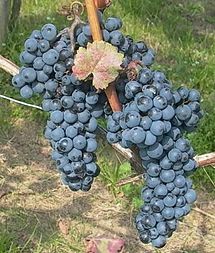- Blaufränkisch
-
Blaufränkisch Grape (Vitis) Blaufränkisch grapes growing in Burgenland, Austria Species Vitis vinifera Also called Lemberger, Blauer Limberger, Frankovka (Franconia), Modra frankinja, Kékfrankos, Gamé Origin Limberg Notable regions Sopron, Villány, Szekszárd and Eger Notable wines Egri Bikavér Blaufränkisch (German for blue "Frankish") is a dark-skinned variety of grape used for red wine.[1] Blaufränkisch, which is a late-ripening variety gives red wines which are typically rich in tannin and may exhibit a pronounced spicy character. The grape is grown across Central Europe, including Austria, Czech Republic (in particular southern Moravia where it is known as Frankovka), Germany (where it is known as Lemberger, or Blauer Limberger), Slovakia (where it is known as "Frankovka modrá"), Croatia ("frankovka") and Slovenia (known as "modra frankinja"). In Hungary the grape is called Kékfrankos (also lit. blue Frankish) and is grown in a number of wine regions including Sopron, Villány, Szekszárd, and Eger (where it is a major ingredient in the famous red wine blend known as Egri Bikavér (lit. Bull's Blood) having largely replaced the Kadarka grape). It has been called "the Pinot Noir of the East" because of its spread and reputation in Eastern Europe.[1]
DNA profiling has shown that Blaufränkisch is a cross between Gouais blanc (Weißer Heunisch) and an unidentified Frankish variety.[2] One of the candidates for the Frankish parent is Blauer Silvaner.[1]
For a long time before the application of DNA analysis, Blaufränkisch was erroneously thought to be a clone of the Gamay grape variety, due to certain similarities in morphology and possibly due to its name Gamé in Bulgaria.[1]
The German name Lemberger derives from the fact that it was imported to Germany in the 19th century from Lemberg in Lower Styria in present-day Slovenia and then in the Austro-Hungarian Empire. A 1877 export of Lembergerreben to Germany has been recorded. The almost identical name Limberger refers to Limburg at Maissau in Lower Austria, where in late 19th century "ungrafted Limberg Blaufränkisch vines" (wurzelechte Limberger Blaufränkisch-Reben) were offered for sale.[1]
Washington State is one of the few major wine regions in North America to have significant plantings of Lemberger. Grapes of this Washington wine mostly grow in Yakima Valley, but also at the Olympic Peninsula. Small amounts of Lemberger are also grown in New York State, Colorado,[3] Ohio, and Virginia.[4]
Contents
Blaufränkisch in Austria
It is possible that Blaufränkisch or a similar forerunner of the grape was cultivated in regions of present Austria (Lower Austria and Burgenland) already in the 10th century.[1][5] In his 1777 publication Beschreibung der in der Wiener Gegend gemeinen Weintrauben-Arten, ampelographer Sebastian Helbling counted the variety as one of the best red grape varieties of Lower Austria, and used the name Schwarze Fränkische for it.[1]
In present-day Austria Blaufränkisch is the second most important red grape variety, and covers 5% of the vineyards.[5] It is particularly common in Mittelburgenland, which is sometimes given the nickname "Blaufränkischland".[6]
Blaufränkisch in Czech Republic
Blaufränkisch is the second most widely grown red grape variety in the Czech Republic.[7] It is grown only in the Moravian wine subregions due to its late-ripening nature.
Blaufränkisch in Australia
The first and currently the only producer of Blaufränkisch in Australia is Hahndorf Hill Winery in the Adelaide Hills wine region of South Australia. The vines were planted approximately 20 years ago. Victorian producer, Mac Forbes, has recently planted Blaufränkisch in the Yarra Valley in 2010.
Blaufränkisch wines
Blaufränkisch wines have aromas of dark ripe cherries and dark berries, are spicy, have medium tannin levels and sometimes very good acidity. Young wines are deeply fruity and become more velvety, supple and complex with age.[5][8]
Offspring
Blaufränkisch has been used in numerous crossings to produce new grape varieties, a few being:[1]
- Acolon = Blaufränkisch x Dornfelder
- Blauburger and Heroldrebe, both being Blauer Portugieser x Blaufränkisch
- Zweigelt = St. Laurent x Blaufränkisch - Austria's most grown red variety.
- André = Frankovka modrá x St. Laurent - grown in Czech Republic and Slovakia
References
- ^ a b c d e f g h Wein-Plus Wein-Glossar: Blaufränkisch, accessed on April 23, 2008
- ^ Vitis International Variety Catalogue: Blaufraenkisch, accessed on April 23, 2008
- ^ [MacNeil, K. 2001. The Wine Bible. Workman Publishing, New York.], MacNeil, K.
- ^ Blue Frankish – A Great Wine By Any Name WineCompass
- ^ a b c Wines from Austria, Press Release April 2006: "Blaufränkisch – So Magnificent"
- ^ Wein-Plus Wein-Glossar: Blaufränkischland, accessed on April 23, 2008
- ^ Wine of Czech Republic: Statistics & Charts, accessed on June 26, 2011
- ^ Wines from Austria: Blaufränkisch, accessed on April 23, 2008
Wines General Wine styles Grape varieties International
varietiesWhiteRedRegional
varietiesWine-producing countries (regions) - New South Wales
- South Australia
- Tasmania
- Victoria
- Western Australia
OtherCategories:- Red wine grape varieties
- Austrian wine
- Czech wine
- Hungarian wine
- Slovak wine
- German words and phrases
Wikimedia Foundation. 2010.

